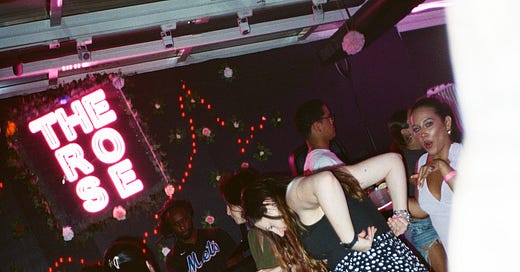-To read this piece and others in the print version of the zine. Order here.
-To celebrate our anniversary, we are offering 50% off on annual subs.
In Latin America, it is socially expected that a young, private-school-type with disposable income (aka access to dad’s money) go to dance clubs or antros, as they are known here. This was unfortunate for me during high school and college, as I’ve never particularly enjoyed clubbing. However, not being one to deviate from the norm, I regularly went along, spending an ill-considered amount of money for bottle and table service, permanently damaging my eardrums with reggaeton booming out of speakers that seemed as loud as a jet engine, and inevitably having fun. For this reason, despite my predisposition against clubs and loud parties, I’ve often found myself looking for one when traveling abroad.
A few years ago, I visited a cousin who was spending a semester at Berkeley. The college’s reputation as a bastion for liberality and progressiveness awakened a desire for a party in me, and I believed the famously raucous university would have no trouble fulfilling my desires. I was thoroughly disappointed. On the first night, we scoured the infamous Telegraph Avenue in search of revelry, which unfortunately came to us only in the form of shuffleboard inside the one bar that opened after 10:00 PM. Suffice it to say, it was pretty dead. After being summarily defeated in shuffleboard many times by the few enthusiastic regulars, we continued our search. Having found none of the craziness I had hoped for, and having drunk one beer too many, I resorted, to the dismay of my cousin, to join a group of protesters who were yelling outside of the Asian studies building at 2:00 AM for some reason.
Hopes were high for day two, since we were invited to attend a pre-game party with members of various fraternities. However, instead of witnessing the type of event that is regularly associated with the American university experience thanks to movies like Neighbors, 22 Jump Street, and Spring Breakers, I found myself in the middle of an environment of sad debauchery that is difficult to describe. There was certainly plentiful booze and loud music, but nobody seemed to be having any real fun. With every “woo”, be it from the men or the women, the true nature of the melancholic ambiance became more and more self-evident. The pop hits that were loudly playing did not lend themselves to dancing. The men seemed afraid of the women, who were scantily clad but lacked any grace or attractiveness whatsoever. To compensate for the lack of flirtation, the attendants resorted to endless shots, and, even though it was barely noon, a visit to the bathroom entailed solving a maze of piss and vomit. That day, I was offered cocaine a total of three times, which is three times more than I had ever been offered beforehand.
When partying in the USA, one seems to be stuck between a choice of a Project X-type situation and a pizza get-together at your local church’s basement. It may be true that I’m particularly bad at finding a fun party, but I’m also far from the first person to point out this dichotomy of boredom and off-putting licentiousness in American parties, clubs, or bars.
Sometimes, a party that is both boring and excessive can happen in the same place and time. Once, after spending the day skiing in one of America’s most popular and crowded ski towns, a small group of friends and I decided to search for a bar to get a drink. This group included a family member who was a certified expert in having a good time, as was evidenced to me on a trip to Switzerland a few years before. In spite of his expertise, and being a town filled with hundreds of young people, we were only able to find one bar that was open and that wouldn’t let us order more than one drink per hour. The bar was almost empty except for yet another shuffleboard (the bane of my existence). After a while, a couple of hooligans, who had definitely had more than alcohol, entered the bar and started accosting the bartender. Everyone was kicked out and the bar was forced to close within fifteen minutes.
For foreigners, be they European or Latin American, the United States has long been one of the worst countries to have fun in. Normally, when making a “Eurotrip” itinerary, cities and locations that would otherwise be ignored by regular tourists are swarmed upon by international legions of recent high school graduates. The segment of the American population composed of young, college-aged kids with money seems to agree with the European and Latin American sentiment concerning parties, as they have abandoned Florida’s party scene for the beaches and clubs of Mexico, Spain, and Greece. Even places like Sin City or Miami, which have built a reputation as places of fun, are no longer considered meccas for national or international partying, given that they’ve become gaudy and déclassé.
A regular American may be indifferent to foreigners’ opinions about their parties. Nevertheless, asking why the current state of affairs is as it is can give us valuable insight into American youth culture, and can provide us with a possible path towards diminishing the deadly atomization many young people suffer from in the United States. There are many reasons (which we won’t detail here) why Americans seem to be trapped in this dichotomy of debauchery and boredom. Their strange relationship with alcohol could be counted among them, as Americans have never been able to truly shake off a social stigma associated with it, leaving them to over-indulge in it or avoid it completely. Another may be their avoidance of unnecessary physical contact, which has led to a historically prohibitive attitude toward dancing, or an exciting feeling of taboo-breaking whenever one allows himself to participate in it. Footloose was popular for a reason.
Letting loose on a whim is one of the hardest things a person can attempt to do, similar to someone purposely trying to think of nothing. The effort put into “letting loose” and the nature of the act in itself are in contradiction, which is why it is generally accepted knowledge that a party cannot be forced; one must fall into one, so to speak. What will a group fall into when letting loose? The essence of a community’s culture may provide an answer. Latin culture, for better or worse, finds at its base a laid-back predisposition with fluctuating bouts of spectacle. It’s no wonder then that Latins find it easy to “fall into” a party. WASPs, on the other hand, generally require an effort to escape their culture’s base instinct of propriety and conscientiousness, which, to be fair, has given them economic supremacy on the world stage.
Whatever the cause, I invite them to take a trip down to Mexico to learn a thing or two from us about how to have spontaneous, revelrous fun. These days, we could all benefit from it.
Germán is a writer and lawyer based in Mexico City. He is currently working in NYC as a junior fellow for First Things magazine.
@germansaucedod @german_saucedo






I found your article interesting and provocative. I can relate to it even though I'm 70 years old and faithfully married. But in my own way I also default into sensuality or lethargy. I'm involved with an Italian catholic group which is able to party, but not usually in the adolescent way. We sing, many play soccer or other sport. We share a commitment to family, friends, faith, and food.
This is the truest thing I’ve ever read. I cannot overstate how much moving to Europe for grad school changed my life—for many reason, including the experience of social gatherings that were actually fun for the first time in my life.